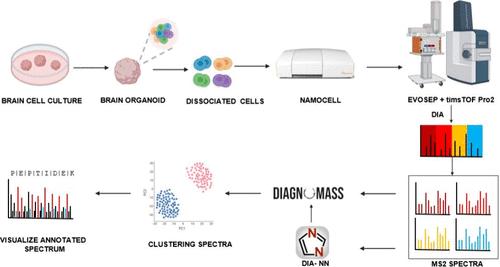Integrating DIA Single-Cell Proteomics Data with the DiagnoMass Proteomic Hub for Biological Insights
IF 3.1
2区 化学
Q2 BIOCHEMICAL RESEARCH METHODS
Journal of the American Society for Mass Spectrometry
Pub Date : 2024-09-11
DOI:10.1021/jasms.4c00187
引用次数: 0
Abstract
Single-cell proteomics has emerged as a powerful technology for unraveling the complexities of cellular heterogeneity, enabling insights into individual cell functions and pathologies. One of the primary challenges in single-cell proteomics is data generation, where low mass spectral signals often preclude the triggering of MS2 events. This challenge is addressed by Data Independent Acquisition (DIA), a data acquisition strategy that does not depend on peptide ion isotopic signatures to generate an MS2 event. In this study, we present data generated from the integration of DIA single-cell proteomics with a version of the DiagnoMass Proteomic Hub that was adapted to handle DIA data. DiagnoMass employs a hierarchical clustering methodology that enables the identification of tandem mass spectral clusters that are discriminative of biological conditions, thereby reducing the reliance on search engine biases for identifications. Nevertheless, a search engine (in this work, DIA-NN) can be integrated with DiagnoMass for spectral annotation. We used single-cell proteomic data from iPSC-derived neuroprogenitor cell cultures as a test study of this integrated approach. We were able to differentiate between control and Rett Syndrome patient cells to discern the proteomic variances potentially contributing to the disease’s pathology. Our research confirms that the DiagnoMass-DIA synergy significantly enhances the identification of discriminative proteomic signatures, highlighting critical biological variations such as the presence of unique spectra that could be related to Rett Syndrome pathology.

将 DIA 单细胞蛋白质组学数据与 DiagnoMass 蛋白质组学中枢整合以获得生物学洞察力
单细胞蛋白质组学已成为揭示细胞异质性复杂性的一项强大技术,有助于深入了解单个细胞的功能和病理。单细胞蛋白质组学的主要挑战之一是数据生成,因为低质谱信号往往无法触发 MS2 事件。数据独立采集(DIA)解决了这一难题,这种数据采集策略不依赖肽离子同位素特征来生成 MS2 事件。在本研究中,我们展示了将 DIA 单细胞蛋白质组学与 DiagnoMass Proteomic Hub 的一个版本相整合而生成的数据,该版本经过调整以处理 DIA 数据。DiagnoMass 采用了一种分层聚类方法,能够识别对生物条件有鉴别作用的串联质谱簇,从而减少了对搜索引擎识别偏差的依赖。尽管如此,搜索引擎(在本研究中为 DIA-NN)仍可与 DiagnoMass 集成,以进行质谱注释。我们使用 iPSC 衍生的神经祖细胞培养物的单细胞蛋白质组数据作为这种集成方法的测试研究。我们能够区分对照组细胞和雷特综合征患者细胞,从而发现可能导致该疾病病理变化的蛋白质组差异。我们的研究证实,DiagnoMass-DIA 的协同作用大大提高了鉴别蛋白质组特征的鉴定能力,突出了关键的生物变异,如可能与雷特综合征病理有关的独特光谱的存在。
本文章由计算机程序翻译,如有差异,请以英文原文为准。
求助全文
约1分钟内获得全文
求助全文
来源期刊
CiteScore
5.50
自引率
9.40%
发文量
257
审稿时长
1 months
期刊介绍:
The Journal of the American Society for Mass Spectrometry presents research papers covering all aspects of mass spectrometry, incorporating coverage of fields of scientific inquiry in which mass spectrometry can play a role.
Comprehensive in scope, the journal publishes papers on both fundamentals and applications of mass spectrometry. Fundamental subjects include instrumentation principles, design, and demonstration, structures and chemical properties of gas-phase ions, studies of thermodynamic properties, ion spectroscopy, chemical kinetics, mechanisms of ionization, theories of ion fragmentation, cluster ions, and potential energy surfaces. In addition to full papers, the journal offers Communications, Application Notes, and Accounts and Perspectives

 求助内容:
求助内容: 应助结果提醒方式:
应助结果提醒方式:


